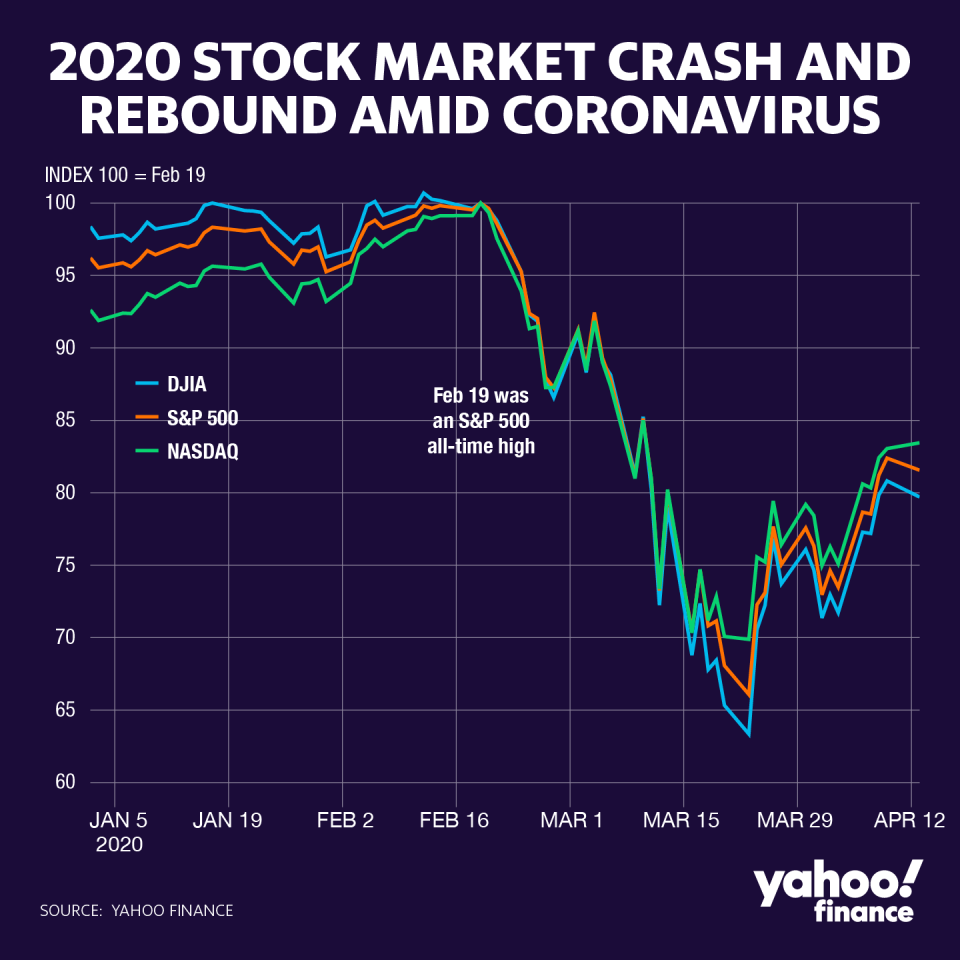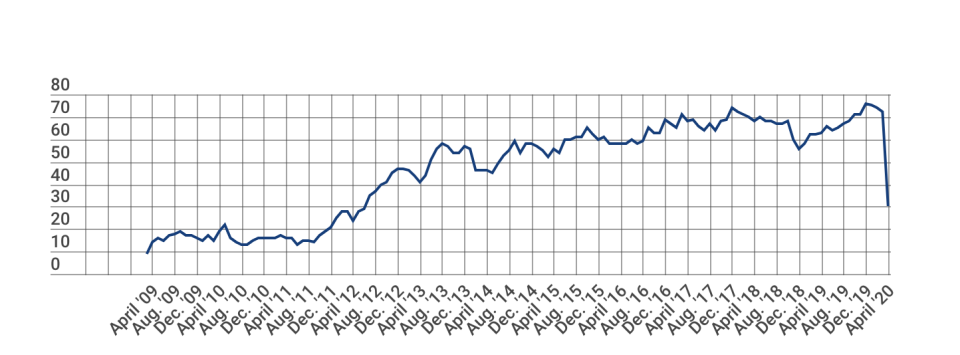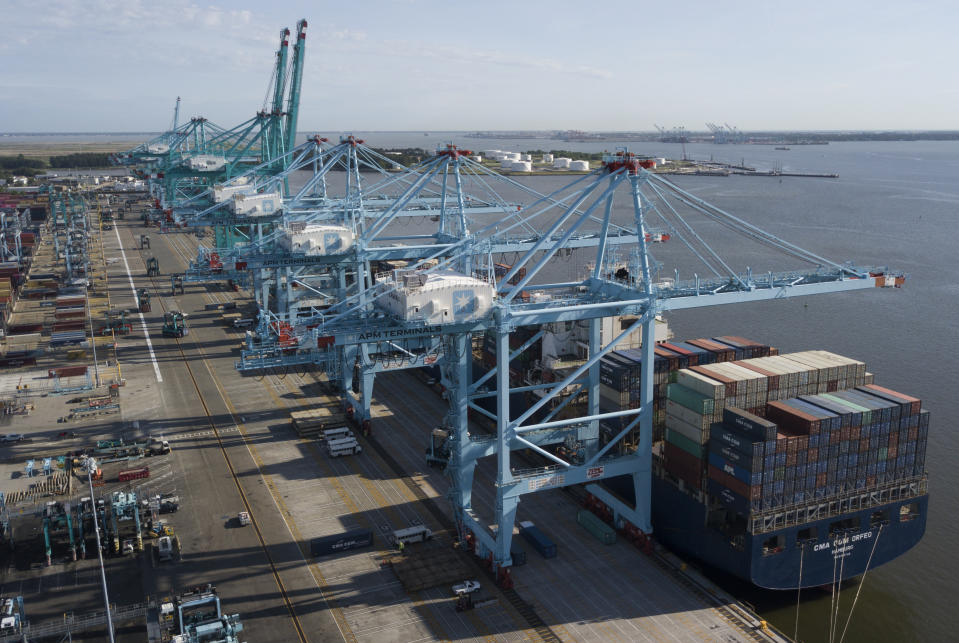Stock market news live updates: Stocks fall after grim economic, earnings data
Stocks fell Wednesday after new economic data showed U.S. retail sales and manufacturing output each declined by massive margins in March amid the coronavirus pandemic. Big banks including Goldman Sachs and Bank of America reported steep year on year declines in profitability for the first quarter.
Meanwhile, the federal government made more progress in helping to provide aid to companies and industries most deeply undercut by the pandemic. After market close, the U.S. Treasury announced preliminary agreements to provide at least 10 U.S. airlines with access to billions of dollars in funds to help support the carriers as demand – and revenues – drop off.
[Click here to read what’s moving markets heading into Thursday, April 15]
In New York, the state hit hardest by coronavirus cases, new deaths rose by 752 on Tuesday, ticking down slightly from Monday’s death toll and bringing overall statewide deaths to 11,586. Governor Andrew Cuomo on Wednesday announced he will issue an order for all New Yorkers to wear a mask while in public.
Globally, the number of confirmed COVID-19 cases crossed two million for the first time on Wednesday, according to Johns Hopkins data.
While death tolls remain elevated in absolute terms, widespread social distancing measures have mostly showed signs of “flattening the curve” for new cases in New York and in hot spots across the U.S. With these early signs in mind, some state leaders on Tuesday provided further details about the shape of an eventual economic reopening. California Governor Gavin Newsom unveiled his state’s plan Tuesday late afternoon, which outlined the state’s list of considerations for easing social distancing standards without providing a specific timeline.

—
4:02 p.m. ET: Dow closes down 445 points after data shows extent of hit to retail and manufacturing
Here were the main moves in markets as of 4:02 p.m. ET:
S&P 500 (^GSPC): -62.70 (-2.20%) to 2,783.36
Dow (^DJI): -445.41 (-1.86%) to 23,504.35
Nasdaq (^IXIC): -122.56 (-1.44%) to 8,393.18
Crude (CL=F): +$0.32 (+1.59%) to $20.43 a barrel
Gold (GC=F): -$23.70 (-1.34%) to $1,745.20 per ounce
10-year Treasury (^TNX): -11.4 bps to yield 0.6380%
—
2:50 p.m. ET: U.S. crude oil prices settles at lowest level since 2002
West Texas intermediate crude oil futures settled 1.2% lower to $19.87 per barrel on Wednesday, hitting the lowest settlement since February 2002. The drop brought the commodity’s year to date price declines to 67%.
Brent crude, the international standard, also settled lower, reversing early gains to end 6.45% lower at $27.69 per barrel.
—
12:14 p.m. ET: Stocks extend declines, Dow drops 600+ points
Stocks extended declines as trading rolled on during intraday trading.
The Energy sector led declines in the S&P 500, as domestic crude oil prices fell below $20 per barrel after the Energy Information Administration announced a record 19.2 million barrels of oil build in supply for the week ended April 10. Energy majors Exxon Mobil and Chevron underperformed in the Dow.
Here were the main moves in markets, as of 12:14 p.m. ET:
S&P 500 (^GSPC): -79.22 points (-2.78%) to 2,766.84
Dow (^DJI): -647.69 points (-2.7%) to 23,302.07
Nasdaq (^IXIC): -171.63 points (-2.02%) to 8,342.87
Crude (CL=F): -$0.59 (-2.93%) to $19.52 a barrel
Gold (GC=F): -$30.50 (-1.72%) to $1,738.40 per ounce
10-year Treasury (^TNX): -11.7 bps to yield 0.633%
—
10:15 a.m. ET: Business inventories dropped in February, extending January decline
Business inventories, a key component of gross domestic product, dropped by 0.4% in February after a 0.3% drop in January, the Commerce Department said Wednesday. The margin of decline was about in-line with consensus expectations, based on Bloomberg data. The data captured the period before much of domestic economic activity halted due to social distancing measures related to the pandemic.
By category, wholesale inventories declined 0.7% for the month, while manufacturers’ inventories declined 0.3% in February.
—
10:00 a.m. ET: National Association of Home Builders confidence index drops by most on record in April
Homebuilder sentiment fell by the most on record in April, according to the National Association of Home Builders monthly Housing Market Index.
The headline index dropped to 30 in April from 72 in March, missing consensus expectations for a drop to just 55. The level was the lowest since June 2012.
“The unprecedented drop in builder confidence is due to the coronavirus outbreak across the nation, as unemployment has surged and gaps in the supply chain have hampered construction activities,” Robert Dietz, NAHB chief economist, said in a statement. “Builders have also expressed confusion over eligibility for the Paycheck Protection Program, as some builders have successfully submitted loan applications while others have not been able to.”

—
9:36 a.m. ET: Manufacturing output falls by the most in more than seven decades in March
U.S. manufacturing production dropped by 6.3% in March, or the most since 1946, according to data from the Federal Reserve Wednesday.
Consensus economists expected manufacturing production to fall by 4.1% for the month, according to Bloomberg data.
Industrial production, a measure that includes mining and utilities output, declined 5.4% in March over the prior month, which was also the most since 1946. Capacity utilization dropped to a 10-year low of 72.7%, indicating smaller portions of plants were in use in March.
—
9:33 a.m. ET: Stocks open lower
Here were the main moves in markets, as of 9:33 a.m. ET:
S&P 500 (^GSPC): -65.75 points (-2.31%) to 2,780.31
Dow (^DJI): -544.14 points (-2.27%) to 23,405.62
Nasdaq (^IXIC): -156.69 points (-1.85%) to 8,359.22
Crude (CL=F): -$0.22 (-1.09%) to $19.89 a barrel
Gold (GC=F): -$18.90 (-1.07%) to $1,750.00 per ounce
10-year Treasury (^TNX): -7.6 bps to yield 0.674%
—
9:20 a.m. ET: Best Buy to furlough about 51,000 employees
Best Buy (BBY) announced Wednesday that it will be temporarily furloughing about 51,000 domestic hourly store employees starting April 19 in a bid to cut costs as brick and mortar stores remain closed during the pandemic. Furloughed employees will continue to receive health benefits for at least three months, and about 82% of full-time employees will continue getting paid.
Best Buy had nearly 125,000 full-time, part-time and seasonal employees in the U.S., Canada and Mexico at the end of its fiscal year ended February 1.
The company, which still offers curbside pick-up and online delivery as physical stores stay closed, said it has so far retained about 70% of its sales compared to last year. Domestic online sales are up 250%, Best Buy said.
—
8:45 a.m. ET: Empire State Index collapses by record amount
In case you were wondering how bad the manufacturing sector is faring amid the coronavirus pandemic...it’s just as bad as you thought (or maybe even worse). The Fed’s New York State manufacturing index plunged in April at its fastest ever pace, as work stoppages around the country crushed activity. Stock futures are pointing sharply lower as COVID-19 fears resurface with a vengeance.

—
8:30 a.m. ET: Retail sales fall by the most on record as pandemic hits consumer spending
Retail sales dropped by 8.7% in March from February, the Commerce Department said in its advance monthly sales report Wednesday, as the coronavirus pandemic began to dent consumer spending. Consensus economists expected headline retail sales to drop by 8.0%, according to Bloomberg data. In February, retail sales dropped by just 0.4% over the prior month.
March’s declines were led by a 50.5% drop in clothing and accessory stores, as well as a 26.8% month on month drop in home furnishing stores. Food service and drink places – many of which have had to halt operations entirely amid social distancing measures – saw sales drop 26.5%.
—
7:27 a.m. ET: Goldman Sachs first-quarter global markets results beat expectations, but overall profitability hit amid pandemic
Goldman Sachs (GS) reported better than expected first quarter results in its trading business, while joining its peers in posting a year on year decline in profitability as the bank set aside capital for loan losses.
The bank’s first-quarter fixed income trading revenues rose 33% over last year to $2.97 billion, its highest level in five years and above expectations for $2.31 billion, according to Bloomberg data. Equities sales and trading revenue grew 22% to $2.19 billion, topping estimates for $2.05 billion.
Goldman Sachs’ provision for credit losses totaled $937 million for the first quarter, rising from $224 million during the same quarter last year, “primarily due to significantly higher provisions related to corporate loans as a result of continued pressure in the energy sector and the impact of COVID-19 on the broader economic environment,” according to a statement.
Overall, the bank’s first quarter earnings were $3.11 per share, down from $5.71 per share last year.
“Our quarterly profitability was inevitably affected by the economic dislocation,” CEO David Solomon said in a statement. “As public policy measures to stem the pandemic take root, I am firmly convinced that our firm will emerge well-positioned to help our clients and communities recover.”
—
7:19 a.m. ET: Stock futures drop in pre-market trading
Stocks fell Wednesday morning as investors continued to monitor corporate earnings and coronavirus developments.
Here were the main moves in markets, as of 7:19 a.m. ET:
S&P 500 futures (ES=F): down 49.75 points, or -1.75% to 2,793.25
Dow futures (YM=F): down 362 points, or -1.52% to 23,518.00
Nasdaq futures (NQ=F): down 93.25 points, or -1.07% to 8,599.25
Crude (CL=F): -$0.26 (-1.29%) to $19.85 a barrel
Gold (GC=F): -$18.30 (-1.03%) to $1,750.60 per ounce
10-year Treasury (^TNX): -6 bps to yield 0.69%
—
7:02 a.m. ET Wednesday: Bank of America sets aside $4.76 billion for credit losses, sees quarterly profit nearly cut in half
Bank of America (BAC) said in quarterly results Wednesday its provision for credit losses jumped to $4.76 billion, or the largest amount since 2010, driven by a $3.6 billion reserve build as the bank braces for a strained lending environment given the coronavirus outbreak. JPMorgan Chase and Wells Fargo announced similar multi-billion-dollar provisions on Monday.
The move contributed to a near halving of Bank of America’s quarterly profit over last year, with net income falling to $4.01 billion for the quarter ended March 31 from $7.31 billion a year earlier. Closely watched net interest income, or the amount that banks bring in from customer loan payments less the bank’s costs to pay depositors, fell by 2% to $12.1 billion.
—
6:09 p.m. ET Tuesday: Stock futures flat after rally
Here were the main moves at the start of the overnight session for U.S. equity futures, as of 6:09 p.m. ET Tuesday:
S&P 500 futures (ES=F): down 2 points, or -0.07% to 2,841.00
Dow futures (YM=F): up 12 points, or +0.05% to 23,892.00
Nasdaq futures (NQ=F): down 0.5 points, or -0.01% to 8,682.00
—
Follow Yahoo Finance on Twitter, Facebook, Instagram, Flipboard, LinkedIn, and reddit.
Find live stock market quotes and the latest business and finance news
For tutorials and information on investing and trading stocks, check out Cashay